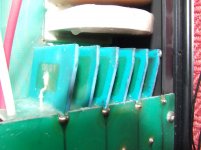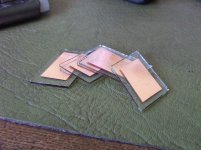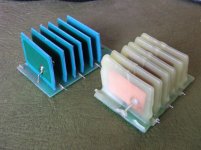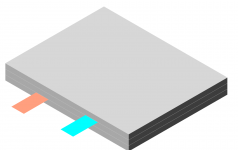I am interested in upgrading the 22pF capacitors used in the ESL-63 delay line. Quad initially used ceramic types before fitting these (see attached) in later ESL63s. Does anyone know what type these are?
Looking around the web I have been unable to find plastic film capacitors of the right value and with a suitably high voltage rating so I have decided to make my own. A prototype which I quickly knocked up using guesswork and some self adhesive aluminium foil stuck to either side of 3mm of perspex (plexiglass) actually measures closely (20pF) and should have a voltage rating many times that which is needed, so high quality DIY capacitors here seem both feasible and easy due to the very small capacitance required.
Any input from anyone with any answers/suggestions would be very welcome.
Thanks,
Tim.
Looking around the web I have been unable to find plastic film capacitors of the right value and with a suitably high voltage rating so I have decided to make my own. A prototype which I quickly knocked up using guesswork and some self adhesive aluminium foil stuck to either side of 3mm of perspex (plexiglass) actually measures closely (20pF) and should have a voltage rating many times that which is needed, so high quality DIY capacitors here seem both feasible and easy due to the very small capacitance required.
Any input from anyone with any answers/suggestions would be very welcome.
Thanks,
Tim.
Attachments
These look like something Quad had made, look like double sided pcb cut and etched as required, I shall have a look inside my 989s shortly
Stuart
Stuart
I have been wondering about that myself - their non-square parallelogram shape making the board easier to remove and install.
I wonder what the dielectric is.
Tim
I wonder what the dielectric is.
Tim
I shall have a closer look but the look like standard fiberglass board so most of the dielectric would be epoxy resin, they should be mechanically stable so possibly a good choice, I would think they are also quite closely matched
Stuart
Stuart
Interesting idea DIYing capacitors. I just wanted to mention though that not all ceramic capacitors are bad. Actually, the low-pF NPO or COG type ceramic caps, or "RF porcelain" types are some of the best types available, particularly in surface-mount. It was mostly the awful Z5U or Y5V caps that gave ceramic a bad name.
I agree. I've auditioned both good and bad sounding ceramics in the signal path. In fact I have two pairs of otherwise identical ESL-63s and I marginally prefer the sound of the older pair which use ceramic (ITT) capacitors. I note there are resistors connected in series with these - Quad's service manual states that they stopped fitting the resistors after upgrading to 'improved' capacitors (flat types) which had no need for them. I'd like to know what function the resistors served.
Today I fitted the glass capacitors and can report that they sound very good indeed. In the treble they are better than both the other types, though I need to do more listening.
Using 2mm picture glass they end up about the same size as Quad's, with a theoretical 16kVDC rating, hopefully enough to allow for any impurities in the glass. 10% tolerance is easily managed. Dipped in beeswax.
Tim
Today I fitted the glass capacitors and can report that they sound very good indeed. In the treble they are better than both the other types, though I need to do more listening.
Using 2mm picture glass they end up about the same size as Quad's, with a theoretical 16kVDC rating, hopefully enough to allow for any impurities in the glass. 10% tolerance is easily managed. Dipped in beeswax.
Tim
Attachments
There are pyroceram HV caps out there which are kind of crystallized glass ones.
Beware beewax. It can easily retain substantial amount of water.
I would of used three layers of glass with silicone encapsulation on the edges and plates in between: it's really hard to encapsulate the way you've done in DIY conditions (without vacuum at hand) regardless to the resin used.
Beware beewax. It can easily retain substantial amount of water.
I would of used three layers of glass with silicone encapsulation on the edges and plates in between: it's really hard to encapsulate the way you've done in DIY conditions (without vacuum at hand) regardless to the resin used.
Thanks for your comments.
I had considered three layers of glass but decided against it due to the added complications - though obviously still possible - of attaching the wires to the foil.
Regarding a vacuum, are you referring to the possibility of contaminants such as dust and moisture?
I had considered three layers of glass but decided against it due to the added complications - though obviously still possible - of attaching the wires to the foil.
Regarding a vacuum, are you referring to the possibility of contaminants such as dust and moisture?
The sound.
I've been listening to these for a while now and they are excellent. Compared with Quad's ceramic caps these sound more polished, more extended at the very top end with impressively clean start/stop, for example on piano notes. They are also clearly better than Quad's flat plastic type in my view, with improved depth perspective. Very revealing of bad edits and bad recordings but equally so of good ones and of how transparent (unintended glass analogy) these speakers are.
I had wondered if the ESL panel capacitance would swamp any sonic signature the small delay-line capacitors but this obviously isn't the case. Very worthwhile.
I've been listening to these for a while now and they are excellent. Compared with Quad's ceramic caps these sound more polished, more extended at the very top end with impressively clean start/stop, for example on piano notes. They are also clearly better than Quad's flat plastic type in my view, with improved depth perspective. Very revealing of bad edits and bad recordings but equally so of good ones and of how transparent (unintended glass analogy) these speakers are.
I had wondered if the ESL panel capacitance would swamp any sonic signature the small delay-line capacitors but this obviously isn't the case. Very worthwhile.
Last edited:
I shall have a closer look but the look like standard fiberglass board so most of the dielectric would be epoxy resin...
More glass than epoxy, I would think.
Both. Most FRCs only use the polymer as "glue."
edit: checking some TGA data that we had, it's about 60:40 by weight for the samples I had on hand.
edit: checking some TGA data that we had, it's about 60:40 by weight for the samples I had on hand.
Specific weight/gravity of glass fiber is 2.54
S.W. of cured epoxy is 1.18
2/3d of the volume of FR-4 is epoxy.
S.W. of cured epoxy is 1.18
2/3d of the volume of FR-4 is epoxy.
- Status
- Not open for further replies.
- Home
- Loudspeakers
- Planars & Exotics
- Quad ESL-63 delay-line capacitors




